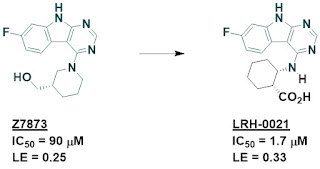Back in 2015,
Practical
Fragments highlighted a new resource calling itself “
The Chemical Probes Portal.” At the time it included just seven probes, and my post concluded, “I
hope this takes off. Understanding the natural world is hard enough even with
well-behaved reagents and carefully controlled experiments.”
Well, take off it has, as
illustrated by a new (open access)
paper in
Nucleic Acids Res. by
Susanne Müller (Goethe University Frankfurt), Bissan Al-Lazikani (MD Anderson
Cancer Center), Paul Workman (Institute of Cancer Research), and collaborators.
The paper notes that “the
widespread use of small molecule compounds that are claimed as chemical probes
but are lacking sufficient quality, especially being inadequately selective for
the desired target or even broadly promiscuous in behavior, has resulted in many
erroneous conclusions in the biomedical literature.” As an antidote, the Portal
is an “expert review-based public resource to empower chemical probe
assessment, selection, and use.”
Any scientist can suggest a potential
probe, and these are then internally reviewed and curated. Assuming enough public
information is available about the molecule, probes are then sent to three members
of a Scientific Expert Review Panel for further vetting. Reviewers rate probes
from one to four stars for use in cellular and/or animal models and recommend relevant
concentration ranges. Importantly, reviewers can also include comments to
highlight off-targets, lack of certain data, oral bioavailability, or anything
else.
From a mere seven probes in 2015
the Portal has grown to include more than 500 molecules covering more than 400
protein targets in about 100 protein families. About two thirds of the probes
have three or more stars, meaning they are recommended. The Portal is very easy
to use and can be searched by probe or protein. Laudably, all the data can also
be easily downloaded in bulk.
In addition to the chemical
probes, the Portal also contains around 250 “Historical Compounds” that have
been described in the literature but “are not recommended to be used to study
the function of specific proteins as they are seriously flawed.” These include
molecules such as
gossypol, a known
aggregator that has been reported as an
inhibitor of multiple proteins, and
curcumin. If you see a molecule used as a
probe in the literature, it’s worth checking to see whether it shows up in the
Portal.
The Chemical Probes Portal features
heavily in a Conversation between Cheryl Arrowsmith (Structural Genomics
Consortium) and Paul Workman
published (open access) last year in
Nat. Commun.
The researchers concisely define chemical probes as “small-molecule modulators
to interrogate the functions of their target proteins, as opposed to protein location,
or other physical properties.” Importantly, they differentiate chemical probes
from drugs. “Drugs don’t necessarily need to be as selective as high-quality
chemical probes. They just need to get the job done on the disease and be safe
to use. In fact, many drugs act on multiple targets as part of their
therapeutic mechanism.” I have frequently heard people make comments such as, “this
is just a probe, not a drug,” but a good probe should actually be
more
selective than many drugs.
That said, you do want a drug to
actually hit the target of interest. The researchers highlight
iniparib, a putative
PARP inhibitor that made it all the way to phase 3 clinical trials for breast
cancer and was tested in >2500 cancer patients. It failed. Moreover, that
failure cast a pall over the field which likely delayed the development of actual
PARP inhibitor drugs.
The researchers also discuss
aggregators, which are still being reported uncritically in the literature,
along with
PAINS. “Such compounds should never be considered further or used as
chemical probes. They should be excluded from compound libraries. Yet many are
sold by commercial vendors as chemical probes and widely used.”
This statement raised the
hackles of Pete Kenny. In a recently published
critique, he states: “it is asserted
in the conversation that commercial vendors are selling compounds as chemical probes
that are unfit for purpose and I strongly recommend that anybody making such
assertions should carefully examine the supporting evidence.”
Dear reader, please try the
following experiment. Enter “iniparib supplier” in your favorite search engine
and see what comes up. For me, the first 10 results include several that
describe it as a PARP inhibitor. I won’t link to them here because I don’t want
to encourage traffic to their sites. (This is also part of the reason
Practical Fragments has discontinued
PAINS shaming, as it only increases the profile of
sloppy or
harmful
papers.)
Pete goes on to write: “I would
strongly advise against making statements that a compound is unfit for use as a
chemical probe unless the assertion is supported by measured data in the public
domain for the compound in question.”
Frankly, I don’t understand Pete’s
position, which I parodied
here. Life is short and biology is complicated, so why
waste time with dirty or inadequately characterized reagents? For me, everything is an artifact until proven
otherwise. And the
Chemical Probes Portal goes a long way towards demonstrating
whether a particular probe is fit for purpose.





